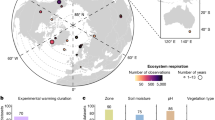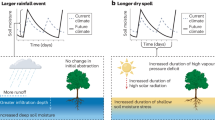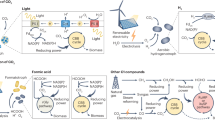Abstract
Agricultural food production is a main driver of global greenhouse gas emissions, with unclear pathways towards carbon neutrality. Here, through a comprehensive life-cycle assessment using data from China, we show that an integrated biomass pyrolysis and electricity generation system coupled with commonly applied methane and nitrogen mitigation measures can help reduce staple crops’ life-cycle greenhouse gas emissions from the current 666.5 to −37.9 Tg CO2-equivalent yr−1. Emission reductions would be achieved primarily through carbon sequestration from biochar application to the soil, and fossil fuel displacement by bio-energy produced from pyrolysis. We estimate that this integrated system can increase crop yield by 8.3%, decrease reactive nitrogen losses by 25.5%, lower air pollutant emissions by 125–2,483 Gg yr−1 and enhance net environmental and economic benefits by 36.2%. These results indicate that integrated biochar solutions could contribute to China’s 2060 carbon neutrality objective while enhancing food security and environmental sustainability.
This is a preview of subscription content, access via your institution
Access options
Access Nature and 54 other Nature Portfolio journals
Get Nature+, our best-value online-access subscription
$29.99 / 30 days
cancel any time
Subscribe to this journal
Receive 12 digital issues and online access to articles
$119.00 per year
only $9.92 per issue
Buy this article
- Purchase on Springer Link
- Instant access to full article PDF
Prices may be subject to local taxes which are calculated during checkout






Similar content being viewed by others
Data availability
The meta-analysis dataset generated during this study is available in Supplementary Data 1. The source data underlying Figs. 1–5 are available in the online version. Source data are provided with this paper.
Code availability
This study does not generate codes.
Change history
24 February 2023
In the version of this article originally published, an earlier version of the paper, before final edits were implemented, was mistakenly used. The updated sections appear at the end of Figure 2 legend (with new text starting “Each scenario is contingent upon the previous one…”), in the second paragraph of the “IPEG–CH4–N” subsection (new text starting “We found that the proportions…”), in one instance each in the Methods and main text, where an earlier typo (“74%”) was corrected in the statement that “By contrast, IPEG–CH4–N requires only 72% of the total crop residue for biochar production…”, while the Supplementary Information presented was an earlier version The updates are made in the HTML and PDF versions of the article.
References
Martin-Roberts, E. et al. Carbon capture and storage at the end of a lost decade. One Earth 4, 1569–1584 (2021).
Liu, Z. et al. Challenges and opportunities for carbon neutrality in China. Nat. Rev. Earth Environ. 3, 141–155 (2022).
Wang, F. et al. Technologies and perspectives for achieving carbon neutrality. Innovation 2, 100180 (2021).
Third National Communication of Climate Change in the People’s Republic of China (Ministry of Ecology and Environment of the People’s Republic of China, 2018).
Chen, X. et al. Producing more grain with lower environmental costs. Nature 514, 486–489 (2014).
Cui, Z. et al. Pursuing sustainable productivity with millions of smallholder farmers. Nature 555, 363–366 (2018).
Liu, B. et al. Promoting potato as staple food can reduce the carbon–land–water impacts of crops in China. Nat. Food 2, 570–577 (2021).
Jiang, Y. et al. Water management to mitigate the global warming potential of rice systems: a global meta-analysis. Field Crops Res. 234, 47–54 (2019).
Shang, Z. et al. Can cropland management practices lower net greenhouse emissions without compromising yield? Glob. Change Biol. 27, 4657–4670 (2021).
Xia, L. et al. Can knowledge-based N management produce more staple grain with lower greenhouse gas emission and reactive nitrogen pollution? A meta-analysis. Glob. Change Biol. 23, 1917–1925 (2016).
Ju, X. et al. Reducing environmental risk by improving N management in intensive Chinese agricultural systems. Proc. Natl Acad. Sci. USA 106, 3041–3046 (2009).
Wang, B. et al. Four pathways towards carbon neutrality by controlling net greenhouse gas emissions in Chinese cropland. Resour. Conserv. Recycl. 186, 106576 (2022).
Xia, L. et al. Trade-offs between soil carbon sequestration and reactive nitrogen losses under straw return in global agroecosystems. Glob. Change Biol. 12, 5919–5932 (2018).
Zhao, Y. et al. Economics- and policy-driven organic carbon input enhancement dominates soil organic carbon accumulation in Chinese croplands. Proc. Natl Acad. Sci. USA 115, 4045–4050 (2018).
Yan, X., Akiyama, H., Yagi, K. & Akimoto, H. Global estimations of the inventory and mitigation potential of methane emissions from rice cultivation conducted using the 2006 Intergovernmental Panel on Climate Change guidelines. Glob. Biogeochemical Cycles 23, GB2002 (2009).
Jiang, Y. et al. Acclimation of methane emissions from rice paddy fields to straw addition. Sci. Adv. 5, eaau9038 (2019).
Chen, Z. et al. Microbial process-oriented understanding of stimulation of soil N2O emission following the input of organic materials. Environ. Pollut. 284, 117176 (2021).
Lugato, E., Leip, A. & Jones, A. Mitigation potential of soil carbon management overestimated by neglecting N2O emissions. Nat. Clim. Change 8, 219–223 (2018).
Xia, L., Wang, S. & Yan, X. Effects of long-term straw incorporation on the net global warming potential and the net economic benefit in a rice-wheat cropping system in China. Agric. Ecosyst. Environ. 197, 118–127 (2014).
Xia, L., Ti, C., Li, B., Xia, Y. & Yan, X. Greenhouse gas emissions and reactive nitrogen releases during the life-cycles of staple food production in China and their mitigation potential. Sci. Total Environ. 556, 116–125 (2016).
Yang, Y. et al. Restoring abandoned farmland to mitigate climate change on a full Earth. One Earth 3, 176–186 (2020).
Lehmann, J. et al. Biochar in climate change mitigation. Nat. Geosci. 14, 883–892 (2021).
Woolf, D., Amonette, J. E., Street-Perrott, F. A., Lehmann, J. & Joseph, S. Sustainable biochar to mitigate global climate change. Nat. Commun. 1, 56 (2010).
Jeffery, S., Verheijen, F. G., Kammann, C. & Abalos, D. Biochar effects on methane emissions from soils: a meta-analysis. Soil Biol. Biochem. 101, 251–258 (2016).
Schmidt, H. P. et al. Biochar in agriculture – a systematic review of 26 global meta-analyses. GCB Bioenergy 13, 1708–1730 (2021).
Cayuela, M. L. et al. Biochar and denitrification in soils: when, how much and why does biochar reduce N2O emissions? Sci. Rep. 3, 1732 (2013).
He, Y. et al. Effects of biochar application on soil greenhouse gas fluxes: a meta-analysis. GCB Bioenergy 9, 743–755 (2017).
Liu, Q. et al. Biochar application as a tool to decrease soil nitrogen losses (NH3 volatilization, N2O emissions, and N leaching) from croplands: options and mitigation strength in a global perspective. Glob. Change Biol. 25, 2077–2093 (2019).
He, X. et al. Effects of pyrolysis temperature on the physicochemical properties of gas and biochar obtained from pyrolysis of crop residues. Energy 143, 746–756 (2018).
Yang, Q. et al. Prospective contributions of biomass pyrolysis to China’s 2050 carbon reduction and renewable energy goals. Nat. Commun. 12, 1698 (2021).
Smith, P. et al. Biophysical and economic limits to negative CO2 emissions. Nat. Clim. Change 6, 42–50 (2016).
IPCC Special Report on Global Warming of 1.5 °C (eds Masson-Delmotte, V. et al.) (WMO, 2018).
Ritchie, H., Roser, M. & Rosado, P. CO2 and Greenhouse Gas Emissions (Our World in Data, 2020); https://ourworldindata.org/co2-and-other-greenhouse-gas-emissions
Liu, Y. et al. A quantitative review of the effects of biochar application on rice yield and nitrogen use efficiency in paddy fields: a meta-analysis. Sci. Total Environ. 830, 154792 (2022).
Cassman, K. G. & Grassini, P. A global perspective on sustainable intensification research. Nat. Sustain. 3, 262–268 (2020).
Gu, B. et al. Abating ammonia is more cost-effective than nitrogen oxides for mitigating PM2.5 air pollution. Science 374, 758–762 (2021).
Yang, Y., Reilly, E. C., Jungers, J. M., Chen, J. & Smith, T. M. Climate benefits of increasing plant diversity in perennial bioenergy crops. One Earth 1, 434–445 (2019).
Weller, S. et al. Methane and nitrous oxide emissions from rice and maize production in diversified rice cropping systems. Nutr. Cycling Agroecosyst. 101, 37–53 (2015).
Rogelj, J. et al. Scenarios towards limiting global mean temperature increase below 1.5 °C. Nat. Clim. Change 8, 325–332 (2018).
Gu, B., Zhang, X., Bai, X., Fu, B. & Chen, D. Four steps to food security for swelling cities. Nature 566, 31–33 (2019).
Zhang, X. et al. Managing nitrogen for sustainable development. Nature 528, 51–59 (2015).
Gu, B., Ju, X., Chang, J., Ge, Y. & Vitousek, P. M. Integrated reactive nitrogen budgets and future trends in China. Proc. Natl Acad. Sci. USA 112, 8792–8797 (2015).
Galloway, J. N. et al. Transformation of the nitrogen cycle: recent trends, questions, and potential solutions. Science 320, 889–892 (2008).
Lee, X. J., Ong, H. C., Gan, Y. Y., Chen, W. H. & Mahlia, T. M. I. State of art review on conventional and advanced pyrolysis of macroalgae and microalgae for biochar, bio-oil and bio-syngas production. Energy Convers. Manag. 210, 112707 (2020).
Nevzorova, T. & Kutcherov, V. Barriers to the wider implementation of biogas as a source of energy: a state-of-the-art review. Energy Strategy Rev. 26, 100414 (2019).
Xia, S. et al. Pyrolysis behavior and economics analysis of the biomass pyrolytic polygeneration of forest farming waste. Bioresource Technol. 270, 189–197 (2018).
Liu, Z., Niu, W., Chu, H., Zhou, T. & Niu, Z. Effect of the carbonization temperature on the properties of biochar produced from the pyrolysis of crop residues. BioResources 13, 3429–3446 (2018).
Hengeveld, E. J., Bekkering, J., van Gemert, W. J. T. & Broekhuis, A. A. Biogas infrastructures from farm to regional scale, prospects of biogas transport grids. Biomass Bioenergy 86, 43–52 (2016).
Ansari, S. H. et al. Incorporation of solar-thermal energy into a gasification process to co-produce bio-fertilizer and power. Environ. Pollut. 266, 115103 (2020).
Yang, S. I., Wu, M. S. & Hsu, T. C. Spray combustion characteristics of kerosene/bio-oil part I: experimental study. Energy 119, 26–36 (2017).
Xia, L. et al. Elevated CO2 negates O3 impacts on terrestrial carbon and nitrogen cycles. One Earth 4, 1752–1763 (2022).
Gu, B. et al. Atmospheric reactive nitrogen in China: sources, recent trends, and damage costs. Environ. Sci. Technol. 46, 9420–9427 (2012).
Xia, L. et al. Greenhouse gas emissions and reactive nitrogen releases from rice production with simultaneous incorporation of wheat straw and nitrogen fertilizer. Biogeosciences 13, 4569–4579 (2016).
Acknowledgements
This work was financially supported by the Helmholtz-OCPC (Office of China Postdoc Council) Postdoc Program and Humboldt Postdoctoral Reserch Fellowship, the National Natural Science Foundation of China (grants 42061124001, 72174197, 72025401, 71974108, 71690244 and 41961124004) and the Tsinghua University-Inditex Sustainable Development Fund. We would like to thank Y. Zhao for providing the SOC data.
Author information
Authors and Affiliations
Contributions
M.Z., L.X., X.L., X.Y. designed the research. L.X. and L.C. performed the data extraction and analysis. L.X. wrote the first draft of the manuscript, with all authors contributing to the revisions.
Corresponding authors
Ethics declarations
Competing interests
The authors declare no competing interests.
Peer review
Peer review information
Nature Food thanks Baojing Gu, Annette Cowie and the other, anonymous, reviewer(s) for their contribution to the peer review of this work.
Additional information
Publisher’s note Springer Nature remains neutral with regard to jurisdictional claims in published maps and institutional affiliations.
Supplementary information
Supplementary Information
Supplementary Notes 1–6, Supplementary Tables 1–20 and Supplementary Figs. 1–9.
Supplementary Data 1
Effects of straw and biochar application on food production and environmental sustainability.
Source data
Source Data Fig. 1
Source data for Fig. 1
Source Data Fig. 2
Source data for Fig. 2
Source Data Fig. 3
Source data for Fig. 3
Source Data Fig. 4
Source data for Fig. 4
Source Data Fig. 5
Source data for Fig. 5
Rights and permissions
Springer Nature or its licensor (e.g. a society or other partner) holds exclusive rights to this article under a publishing agreement with the author(s) or other rightsholder(s); author self-archiving of the accepted manuscript version of this article is solely governed by the terms of such publishing agreement and applicable law.
About this article
Cite this article
Xia, L., Cao, L., Yang, Y. et al. Integrated biochar solutions can achieve carbon-neutral staple crop production. Nat Food 4, 236–246 (2023). https://doi.org/10.1038/s43016-023-00694-0
Received:
Accepted:
Published:
Issue Date:
DOI: https://doi.org/10.1038/s43016-023-00694-0
This article is cited by
-
Exploring negative emission potential of biochar to achieve carbon neutrality goal in China
Nature Communications (2024)
-
Evaluation and obstacle factors diagnosis of Agriculture Green Development level in China’s Yangtze River Basin based on the DPSIR framework
Environment, Development and Sustainability (2024)
-
Estimating the carbon footprint of Mexican food consumption based on a high-resolution environmentally extended input-output model
Environmental Science and Pollution Research (2024)
-
Greenhouse gas emissions and mitigation in rice agriculture
Nature Reviews Earth & Environment (2023)
-
Biochar as a fast track to net zero
Nature Food (2023)



